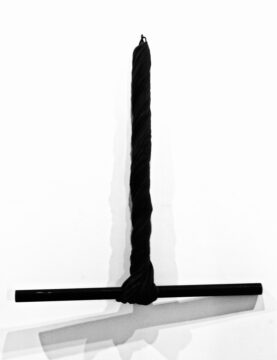Category: Recommended Reading
The Frenchwoman From Indianapolis
Rosa Lyster at The Paris Review:
Here is Norman Mailer in his fine black boots, high-cut and shiny and very snug on the ankle, like something you might pick out if you were the prop master for an expensive production of Richard III. Sweating a bit under the TV lights, he seems to be doing an imitation of a scowl, as if to gesture toward his reputation as a guy who goes around scowling. He sits angled toward the host, Dick Cavett, who bends slightly away from him, as do the other two guests. One of them is Gore Vidal. Like Mailer, Vidal is doing an impersonation of himself. He strikes various languorous attitudes as the camera begins to roll, reclining deeper into his chair as Mailer leans forward, toying idly with his glasses and smiling as Mailer yaps and bares his teeth. A cat and a dog.
Compared to these two, both positively radiant with the excitement of showing off, the third guest seems to have been invited on by mistake. She is, basically, an old lady.
more here.
Wednesday, February 7, 2024
“Everyone on This Train Is a Suspect” by Benjamin Stevenson
Melanie Ho in the Asian Review of Books:
 It’s the Australian Mystery Writers’ Festival and debut author Ernest Cunningham is one of the participating writers. Cunningham arrives at the festival—hosted on the Ghan, the famous train that goes from Darwin to Adelaide—following the publication of his memoir Everyone in My Family Has Killed Someone (also, the title of author Benjamin Stevenson’s novel that first introduces Cunningham) and is, having signed a six-figure advance, now stuck trying to find an idea for a novel.
It’s the Australian Mystery Writers’ Festival and debut author Ernest Cunningham is one of the participating writers. Cunningham arrives at the festival—hosted on the Ghan, the famous train that goes from Darwin to Adelaide—following the publication of his memoir Everyone in My Family Has Killed Someone (also, the title of author Benjamin Stevenson’s novel that first introduces Cunningham) and is, having signed a six-figure advance, now stuck trying to find an idea for a novel.
He’s not stuck much longer. Soon there’s a murder on the train, and with all the festival participants and guests stuck on the Ghan, Cunningham gets to work to solve the murder and get the material he needs for his next book. As Cunningham narrates:
Seven writers board a train. At the end of the line, five will leave it alive. One will be in cuffs.
Everyone on This Train Is a Suspect is Stevenson’s pacey and entertaining follow-up to his first Cunningham novel. While Stevenson, via Cunningham, notes that all of the conventions of the genre will be followed, Stevenson breaks the fourth wall from the opening page and maintains his meta, direct-to-audience style throughout. Early in the novel Cunningham introduces his structural notes for when certain events need to have occurred, including that by 10,000 words the characters, victims and suspects need to be introduced.
More here.
Hurricanes are becoming so strong we may need a new scale to rate them
Michael Le Page in New Scientist:
 In the past decade, five tropical storms had wind speeds so high that they should have been classified as “category 6” storms, according to an analysis that suggests the hurricane scale may need to be updated as rising temperatures fuel stronger storms.
In the past decade, five tropical storms had wind speeds so high that they should have been classified as “category 6” storms, according to an analysis that suggests the hurricane scale may need to be updated as rising temperatures fuel stronger storms.
If carbon emissions continue at current rates, we might even see “category 7” storms. “It certainly is theoretically possible if we keep warming the planet,” says climate scientist James Kossin at the First Street Foundation, a non-profit research organisation in New York.
Officially, there is no such thing as a category 6 or category 7 hurricane. According to the Saffir-Simpson hurricane scale used by the National Hurricane Center (NHC) in the US, any storm with sustained wind speeds of 252 kilometres per hour and over is a category 5.
But as the wind speeds of the strongest storms get faster, the use of this scale is increasingly problematic, say Kossin and his colleague Michael Wehner at the Lawrence Berkeley National Laboratory in California, as it doesn’t convey the increasing risks posed by ever stronger storms.
More here.
Netanyahu, the Palestinians, and the Price of Neglect
Aluf Benn in Foreign Affairs:
 One bright day in April 1956, Moshe Dayan, the one-eyed chief of staff of the Israel Defense Forces (IDF), drove south to Nahal Oz, a recently established kibbutz near the border of the Gaza Strip. Dayan came to attend the funeral of 21-year-old Roi Rotberg, who had been murdered the previous morning by Palestinians while he was patrolling the fields on horseback. The killers dragged Rotberg’s body to the other side of the border, where it was found mutilated, its eyes poked out. The result was nationwide shock and agony.
One bright day in April 1956, Moshe Dayan, the one-eyed chief of staff of the Israel Defense Forces (IDF), drove south to Nahal Oz, a recently established kibbutz near the border of the Gaza Strip. Dayan came to attend the funeral of 21-year-old Roi Rotberg, who had been murdered the previous morning by Palestinians while he was patrolling the fields on horseback. The killers dragged Rotberg’s body to the other side of the border, where it was found mutilated, its eyes poked out. The result was nationwide shock and agony.
If Dayan had been speaking in modern-day Israel, he would have used his eulogy largely to blast the horrible cruelty of Rotberg’s killers. But as framed in the 1950s, his speech was remarkably sympathetic toward the perpetrators. “Let us not cast blame on the murderers,’’ Dayan said. “For eight years, they have been sitting in the refugee camps in Gaza, and before their eyes we have been transforming the lands and the villages where they and their fathers dwelt into our estate.”
More here.
Andrej Karpathy: Introduction to Large Language Models
How do the most prolific people produce so much?
Henry Oliver in The Common Reader:
 Here are four ideas I have long nurtured as suspicions for what makes the most productive people quite so successful, inspired by a recent conversation I had that I’m hoping to bring to you soon. Many people will have aspects of more than one of these criteria—Beethoven, for example.
Here are four ideas I have long nurtured as suspicions for what makes the most productive people quite so successful, inspired by a recent conversation I had that I’m hoping to bring to you soon. Many people will have aspects of more than one of these criteria—Beethoven, for example.
- Instability. Think of the most prolific writers—D.H. Lawrence (seventy-five volumes), Charles Dickens (thirty volumes), Samuel Johnson (twenty-three volumes, plus a whole dictionary and edition of Shakespeare)—and you think of people who are, in some way, mentally unsettled. The recent Joyce Carol Oates profile reinforced this to me. And I learned that Gwern thinks partial mood disorder is behind some people’s productivity.
- Death (and God). John Stuart Mill (thirty-three volumes) was spurred into the late work (On Liberty, Autobiography, Subjection, &c.) by a death scare in 1854. He wrote in his diary that the night cometh when no man can work, a bible quotation which Johnson once had carved on his watch. The most prolific composer, J.S. Bach, might not have been unstable (who knows?), but he wrote for God, and the Lutheran church emphasises preparing for death. Michelangelo was always working to the glory of God, preparing his soul (factor in his work running the building site at St. Peters and he gets way more productive: that building wouldn’t exist without his project management). Montaigne wrote his essays because he was running out of time.
More here.
28 Overlooked Black Artists to Discover This Black History Month
Ayanna Dozier in Artsy:
 In honor of Black History Month, Artsy is featuring the work of 28 Black artists who are not as widely known or celebrated as some of their historical or contemporary peers. This list is meant to shine a light on artists who have prominence within institutions, but are often excluded from mainstream conversations meant to amplify overlooked Black artists or canonize them as leading figures of art history.
In honor of Black History Month, Artsy is featuring the work of 28 Black artists who are not as widely known or celebrated as some of their historical or contemporary peers. This list is meant to shine a light on artists who have prominence within institutions, but are often excluded from mainstream conversations meant to amplify overlooked Black artists or canonize them as leading figures of art history.
Of course, Alma Thomas, Jack Whitten, Sam Gilliam, and Frank Bowling are well-deserved citations of the early Black abstractionists, but lesser known to that history, broadly speaking, are Lilian Thomas Burwell, Evangeline “EJ” Montgomery, and Deborah Dancey. While contemporary artists like Kerry James Marshall, Betye Saar, and Faith Ringgold are the founding leaders of contemporary figurative painting and printmaking, the contributions of artists like Malcolm Bailey, Charles Alston, and Camille Billops may not be as widely discussed. We hope this will serve as an introduction to, rather than a comprehensive list of, Black artists whose legacies deserve to be cemented in art history and public consciousness. Here are 28 need-to-know Black artists from the 20th and 21st centuries.
More here. (Note: In honor of Black History Month, at least one post will be devoted to its 2024 theme of “African Americans and the Arts” throughout the month of February)
Wednesday Poem
View With A Grain of Sand
We call it a grain of sand
but it calls itself neither grain nor sand.
It does just fine without a name,
whether general, particular,
permanent, passing,
incorrect or apt.
Our glance, our touch mean nothing to it.
It doesn’t feel itself seen or touched.
And that it fell on the windowsill
is only our experience, not its.
For it is no different than falling on anything else
with no assurance that it’s finished falling
or that it’s falling still.
The window has a wonderful view of a lake
but the view doesn’t view itself.
It exists in this world
colorless, shapeless,
soundless, odorless, and painless.
The lakes floor exists floorlessly
and its shore exists shorelessly.
Its water feels itself neither wet nor dry
and its waves to themselves are neither singular nor plural.
They splash deaf to their own noise
on pebbles neither large nor small.
And all this beneath a sky by nature skyless
in which the sun sets without setting at all
and hides without hiding behind an unminding cloud.
The wind ruffles it, its only reason being
that it blows.
A second passes.
A second second.
A third.
But they’re three seconds only for us..
Time has passed like a courier with urgent news.
But that’s just our simile.
The character’s invented, his haste is make-believe,
his news inhuman.
by Wislawa Szymborska
from A Book of Luminous Things
Harvest Books, 1996
Reading Dante In Ukraine
Ilya Kaminsky at Asymptote:
 I have a friend who, before she ran from Kyiv as Russia bombarded the city in early 2022, spent weeks shivering in the bomb shelters as the city was shelled.
I have a friend who, before she ran from Kyiv as Russia bombarded the city in early 2022, spent weeks shivering in the bomb shelters as the city was shelled.
At first, she first recited poems by heart, and then she began to translate the poems she remembered.
That is how she got through the hours.
Who is to tell me after this that poetry doesn’t matter?
Opening Dante’s Inferno enrolls the reader in a millennium-long class in surviving hell with poetry, through music, imagery, and poetry’s willingness to look without flinching at the details of both terror and wonder: in a strange way, this book is a call to courage.
more here (via The Book Haven).
A Performance By Ilya Kaminsky
Why We Anthropomorphize Animals (and Always Have)
Hana Videen at Lit Hub:
 Although bestiaries were popular texts in medieval Europe, many of their tales derive from a far older text from northern Africa known as the Physiologus. The Physiologus (meaning Natural Philosopher) was originally written in Greek by an unknown author, probably someone living in Alexandria during the third century CE. This text in turn is made up of stories whose influences can be traced even further back in time to texts on natural philosophy and religion by ancient Greek and Roman writers.
Although bestiaries were popular texts in medieval Europe, many of their tales derive from a far older text from northern Africa known as the Physiologus. The Physiologus (meaning Natural Philosopher) was originally written in Greek by an unknown author, probably someone living in Alexandria during the third century CE. This text in turn is made up of stories whose influences can be traced even further back in time to texts on natural philosophy and religion by ancient Greek and Roman writers.
As the Physiologus further developed over the centuries, its age-old tales were often shaped by contemporary authorities like the third-century geographer and grammarian Solinus, or Ambrose, a fourth-century bishop and theologian. So while the ones of a story might stay the same, the interpretation and moral might shift according to the ideas that pleased the contemporary scribe.
more here.
Tuesday, February 6, 2024
Giovanni Anselmo (1934 – 2023)
Elizabeth Mangini at Artforum:
 Throughout the late 1960s and ’70s, the heyday of Arte Povera and European conceptualism, Anselmo continued to create objects that use the slightest material intervention as a means to heighten viewers’ awareness of the relativity of human existence and the natural forces that determine it. They provoke interrogation without offering resolution. He was invited to take part in Daniela Palazzoli’s groundbreaking Con temp l’azione—a punning title that refers to both contemplation and time-based actions—which was an exhibition that spanned three different Turin galleries and issued a foldout broadsheet as its catalogue. Fittingly, Anselmo created works for this show that reinforced reflection on the way we exist in a nexus of natural and built environments. Direzione (Direction), 1967–68, for instance, is a low triangular slab of schist with a small compass embedded in its surface. The stone is a metamorphic rock, meaning it was formed in response to environmental heat or pressure, and the compass responds to Earth’s magnetic field, indicating the point of reference we call North. Brought together into this succinct arrangement, which reflects the logic of Duchamp’s assisted readymades, the natural material and the manufactured tool offer palpable traces of the ever-present natural forces that determine our sense of the world, even in the supposedly neutral white cube of the gallery.
Throughout the late 1960s and ’70s, the heyday of Arte Povera and European conceptualism, Anselmo continued to create objects that use the slightest material intervention as a means to heighten viewers’ awareness of the relativity of human existence and the natural forces that determine it. They provoke interrogation without offering resolution. He was invited to take part in Daniela Palazzoli’s groundbreaking Con temp l’azione—a punning title that refers to both contemplation and time-based actions—which was an exhibition that spanned three different Turin galleries and issued a foldout broadsheet as its catalogue. Fittingly, Anselmo created works for this show that reinforced reflection on the way we exist in a nexus of natural and built environments. Direzione (Direction), 1967–68, for instance, is a low triangular slab of schist with a small compass embedded in its surface. The stone is a metamorphic rock, meaning it was formed in response to environmental heat or pressure, and the compass responds to Earth’s magnetic field, indicating the point of reference we call North. Brought together into this succinct arrangement, which reflects the logic of Duchamp’s assisted readymades, the natural material and the manufactured tool offer palpable traces of the ever-present natural forces that determine our sense of the world, even in the supposedly neutral white cube of the gallery.
more here.
Conversation Between Giovanni Anselmo and Alberto Fiz
The Trials Of Trucking School
Emily Gogolak at Harper’s Magazine:

“If you have to change friends, that’s what you gotta do,” our instructor, Johnny, told the twelve of us sitting in a makeshift classroom in a strip mall outside Austin. “They’re gonna be so jealous, because you’re gonna be bringing home so much money. Encourage them to get their CDL, too.”
A CDL is a commercial driver’s license, and if you pay attention, you’ll find variations on the phrase cdl drivers wanted everywhere: across interstate billboards, in small-town newspapers, on diner bulletin boards, on TV, and, most often, on the backs of semitrucks. Each of us had come to the Changing Lanes CDL School to answer that call.
Johnny’s rosy pep talk was built on the belief that trucking is still a lucrative career in America. And despite the devastating shortage of truckers observed by media outlets, politicians, and trucking associations, the classroom was full of people who seemed willing to buy in.
more here.
Hi, Mr. W. B. Yeats, this is Ciaran from IT
Alyson Favilla in McSweeney’s:
Right—right—
No, I hear you, things sound pretty stressful over there. How about this, I’ll open the support ticket on my end, and you can talk me through the issue over the phone, okay? Great.
Uh-huh, yeah, I can see why that might be an issue. I have to ask—did you try turning the falcon off and on again?
Right, definitely not ideal.
Oh, true, things do fall apart, but you’re not due for a replacement work computer (a 15″ MacBook Air, it says here) until next year, so let’s see if we can get the current system back up and running.
More here.
Mathematicians finally solved Feynman’s “reverse sprinkler” problem
Jennifer Ouellette in Ars Technica:
 A typical lawn sprinkler features various nozzles arranged at angles on a rotating wheel; when water is pumped in, they release jets that cause the wheel to rotate. But what would happen if the water were sucked into the sprinkler instead? In which direction would the wheel turn then, or would it even turn at all? That’s the essence of the “reverse sprinkler” problem that physicists like Richard Feynman, among others, have grappled with since the 1940s. Now, applied mathematicians at New York University think they’ve cracked the conundrum, per a recent paper published in the journal Physical Review Letters—and the answer challenges conventional wisdom on the matter.
A typical lawn sprinkler features various nozzles arranged at angles on a rotating wheel; when water is pumped in, they release jets that cause the wheel to rotate. But what would happen if the water were sucked into the sprinkler instead? In which direction would the wheel turn then, or would it even turn at all? That’s the essence of the “reverse sprinkler” problem that physicists like Richard Feynman, among others, have grappled with since the 1940s. Now, applied mathematicians at New York University think they’ve cracked the conundrum, per a recent paper published in the journal Physical Review Letters—and the answer challenges conventional wisdom on the matter.
More here.
The Most Important Factor In The Election?
Dan Gardner at PastPresentFuture:
 Good news for Joe Biden this week. Job gains beat forecasts and the phrase “surprisingly strong economy” once again appeared in headlines. Voters mostly refused to acknowledge the good news through 2023 but the latest consumer sentiment surveys suggest the sunshine is finally penetrating the gloom. Optimism is rising. If the economy maintains course through 2024, Biden, for all his faults and weaknesses, will be the heavy favourite for re-election.
Good news for Joe Biden this week. Job gains beat forecasts and the phrase “surprisingly strong economy” once again appeared in headlines. Voters mostly refused to acknowledge the good news through 2023 but the latest consumer sentiment surveys suggest the sunshine is finally penetrating the gloom. Optimism is rising. If the economy maintains course through 2024, Biden, for all his faults and weaknesses, will be the heavy favourite for re-election.
That’s the standard sort of analysis political pundits churn out. It’s true, as far as it goes. But let’s push it a little further so we can make plain something that is seldom explicitly discussed — although it is far more important than what pundits usually yammer on about.
Why does a strong economy favour an incumbent president? Because voters generally credit the president for economy. This is so common, so baked into our thinking, that we seldom ask if it makes any sense.
Which is a shame because it mostly doesn’t.
More here.
‘Like a moth to a flame’ — this strange insect behaviour is finally explained
Tuesday Poem
The moon rose over the bay. I had a lot of feelings
I am taken with the hot animal
of my skin, grateful to swing my limbs
and have them move as I intend, though
my knee, though my shoulder, though something
is torn or tearing. Today, a dozen squid, dead
on the harbor beach: one mostly buried,
one with skin empty as a shell and hollow
feeling, and, though the tentacles look soft,
I do not touch them. I imagine they
were startled to find themselves in the sun.
I imagine the tide simply went out
without them. I imagine they cannot
feel the black flies charting the raised hills
of their eyes. I write my name in the sand:
Donika Kelly. I watch eighteen seagulls
skim the sandbar and lift low in the sky.
I pick up a pebble that looks like a green egg.
To the ditch lily I say I am in love.
To the Jeep parked haphazardly on the narrow
street I am in love. To the roses, white
petals rimmed brown, to the yellow lined
pavement, to the house trimmed in gold I am
in love. I shout with the rough calculus
of walking. Just let me find my way back,
let me move like a tide come in.
by Donika Kelly
from Academy of American Poets, 11/20/17
